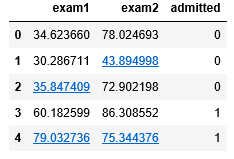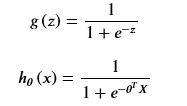一、导入使用模块
import pandas as pd
import numpy as np
import matplotlib.pyplot as plt
import seaborn as sns#画图工具,在matplot上进行API精装
plt.style.use('fivethirtyeight') #样式美化
import matplotlib.pyplot as plt
# import tensorflow as tf
from sklearn.metrics import classification_report#这个包是评价报告
二、导入数据
data = pd.read_csv('F:\\MachineLearning\data\ex2data1.txt', names=['exam1', 'exam2', 'admitted'])
data.head()#看前五行
read_csv中的参数names以列表形式给每一列命名。
如图所示为数据形式:

下面为数据展示:
sns.set(context='notebook',style='darkgrid') #context:设置绘图元素大小(坐标轴标记大小),style:主题风格
sns.set_palette(palette=sns.color_palette("RdBu", 2)) #设置分类色板
sns.lmplot('exam1','exam2',hue='admitted',data=data,height=6,fit_reg=False,scatter_kws={"s": 50})#exam1,exam2:分别在制定的行列上分类
#hua:用于分类的属性,size:设置图的大小,fig_reg:是否显示分类直线,scatter_kws:点的样式大小
plt.show()
得到点图为:

color_palette() 中的第一个参数为颜色风格,第二个参数为色块数。fit_reg表示是否要画出回归曲线。
三、数据处理
def get_X(df):#读取特征
ones = pd.DataFrame({'ones': np.ones(len(df))})#ones所对应的列长度为m全为1
data = pd.concat([ones, df], axis=1) # 合并数据,根据列合并
return data.iloc[:, :-1].as_matrix() # 这个操作返回 ndarray,不是矩阵
def get_y(df):#读取标签
return np.array(df.iloc[:, -1]) #df.iloc[:, -1]是指df的最后一列
def normalize_feature(df):
return df.apply(lambda column: (column - column.mean()) / column.std())#特征缩放
由于要处理逻辑回归中常数项所对应的参数,所以要在X中的第一列添加全为1的列。concact将ones与df合并,axis=1表示按照行的方向合并。最会X除去倒数第一列。y则要取最后一列。normalize_feature为对数据进行归一化,防止在梯度下降过程中迭代过慢。
检查处理后数据的行数和列数:
X = get_X(data)
print(X.shape)
y = get_y(data)
print(y.shape)
得到:
(100, 3)
(100,)
四、sigmoid 函数
sigmoid函数形如:

所以可以编写sigmoid函数的代码:
def sigmoid(z):
return 1/(1+np.exp(-z))
然后展示sigmoid函数的曲线图:
fig, ax = plt.subplots(figsize=(8, 6))
ax.plot(np.arange(-10, 10, step=0.01),
sigmoid(np.arange(-10, 10, step=0.01)))
ax.set_ylim((-0.1,1.1))
ax.set_xlabel('z', fontsize=18)
ax.set_ylabel('g(z)', fontsize=18)
ax.set_title('sigmoid function', fontsize=18)
plt.show()
得到图:

五、代价函数
逻辑回归的代价函数为:

所以代价函数的代码如下:
def cost(theta, X, y):
m=X.shape[0]
sigVector=sigmoid(X@theta)
totalCost=-(y@np.log(sigVector)+(1-y)@np.log(1-sigVector))
return totalCost/m
下面检验其正确性:在这里插入代码片
theta = theta=np.zeros(3)
print(cost(theta, X, y))
得到代价函数的值为0.6931471805599452,发现正确。
六、计算梯度
梯度形式为:

向量形式为:

所以可以计算梯度:
def gradient(theta, X, y):
m=X.shape[0]
deltaVector=sigmoid(X@theta)-y
grad=X.T@deltaVector/m
return grad
七、拟合参数
这里我们不必编写梯度下降算法以得到最优值,只需调用scipy.optimize就可拟合最优值。代码如下:
import scipy.optimize as opt#拟合参数
res = opt.minimize(fun=cost, x0=theta, args=(X, y), method='Newton-CG', jac=gradient)#fun:需要最小化的函数。x0:最初的猜想,
#ndarray, shape (n,)。arg:需要传递给目标函数与及其倒数的参数,fun, jac and hess functions。method:所使用的方法。jac:梯度向量计算方法。
print(res)#res为一个字典,拥有以下属性。x : ndarra,问题的优化求解。success : bool,是否成功。status : int,优化器终止状态。
#message : str,终止状态的说明。fun, jac, hess: ndarray,目标函数的值。hess_inv : object,目标函数Hessian矩阵的逆。
#nfev, njev, nhev : int,目标函数及其雅可比矩阵和黑森矩阵的计算次数。nit : int,优化器执行的迭代次数。maxcv : float,最大约束冲突。
得到最终拟合状态:
fun: 0.2034977015894895
jac: array([-4.33738420e-07, -2.47262193e-05, -2.84907400e-05])
message: 'Optimization terminated successfully.'
nfev: 72
nhev: 0
nit: 29
njev: 256
status: 0
success: True
x: array([-25.16135181, 0.20623186, 0.20147175])
于是最优化theta值为:
array([-25.16135181, 0.20623186, 0.20147175])
八、用训练集预测和验证
用我们拟合得到参数带入逻辑回归,预测样本集中样本的类。首先编写prdict函数的到预测结果。
def predict(x, theta):
fx=sigmoid(X@theta)
pred_list=[]
for a in fx:
if a>=0.5:
pred_list.append(1)
else:
pred_list.append(0)
y_pred=np.array(pred_list)
return y_pred
进行判断:
final_theta = res.x
y_pred=predict(X, final_theta)
print(type(y_pred))
print(classification_report(y, y_pred))
得到预测结果:
<class 'numpy.ndarray'>
precision recall f1-score support
0 0.87 0.85 0.86 40
1 0.90 0.92 0.91 60
micro avg 0.89 0.89 0.89 100
macro avg 0.89 0.88 0.88 100
weighted avg 0.89 0.89 0.89 100
得到判断0的精度为0.87,1的精度为0.9。
九、寻找决策边界
我们把我们拟合的参数作为决策边界的参数,查看拟合参数的拟合情况。
print(res.x)
[-25.16135181 0.20623186 0.20147175]
得到前面的拟合参数。
coef = -(res.x / res.x[2]) # find the equation
print(coef)
x = np.arange(130, step=0.1)
y = coef[0] + coef[1]*x
这一步主要是得到exam2属性关于exam1属性的函数。然后就可以通过曲线图得到拟合情况:
sns.set(context="notebook", style="ticks", font_scale=1.5)
sns.lmplot('exam1', 'exam2', hue='admitted', data=data,
size=6,
fit_reg=False,
scatter_kws={"s": 25}
)
plt.plot(x, y, 'grey')
plt.xlim(0, 130)
plt.ylim(0, 130)
plt.title('Decision Boundary')
plt.show()






















 7万+
7万+











 被折叠的 条评论
为什么被折叠?
被折叠的 条评论
为什么被折叠?








